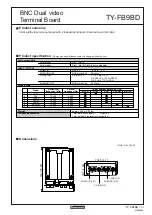
8
accurate readings. Using a bung is the preferred method for mounting the
oxygen sensor in all applications.
Weld the bung at least
24 inches
after the turbocharger.
Using a clock as reference, mount the bung between the
9:00
o’clock and 3:00 o’clock position
. Welding the bung in the lower
section of the exhaust pipe can result in sensor damage caused by
condensation making contact with the sensor’s internal heating
element.
A
1” bung
(provided in the kit) will best protect the sensor. When
fully threaded, the sensor’s tip will sit flush with the inside of the
exhaust piping, this does
not
adversely effect the readings.
The bung should always be welded before the Catalytic Converter.
Welding the bung after the catalytic converter will skew the readings
toward lean. The skew in readings will vary with engine load and the
efficiency of the catalytic converter.
Leaded fuel and two stroke applications will reduce the sensor’s life.
There are many other factors that dictate the sensor’s lifespan so it is
impossible to predict total sensor longevity.
Exhaust leaks, camshaft overlap, and open (shorty) exhausts will
cause false lean readings at light engine loads. Typically, once the
engine is under load and the exhaust gas volume increases, you will
see accurate readings.
When installed in the exhaust, the oxygen sensor must be connected
to a powered, functional SCG-1 (no error codes) whenever the
engine is running. An un-powered sensor will be damaged in a short
period of time when exposed to exhaust gas.
Do not pre-warm the sensor before starting the engine, start the
engine as you normal would. Allowing the sensor to pre-warm
before starting the engine will increase the possibility of damaging
the sensor from shock-cooling.
The maximum temperature of the sensor at the bung (the sensor
mounting location) should not exceed 500
o
C or 900
o
F. If these
temperatures are exceeded in your application you should install the
Innovate Motorsports HBX-1 heat sink bung extender. (p/n 3729.)




































